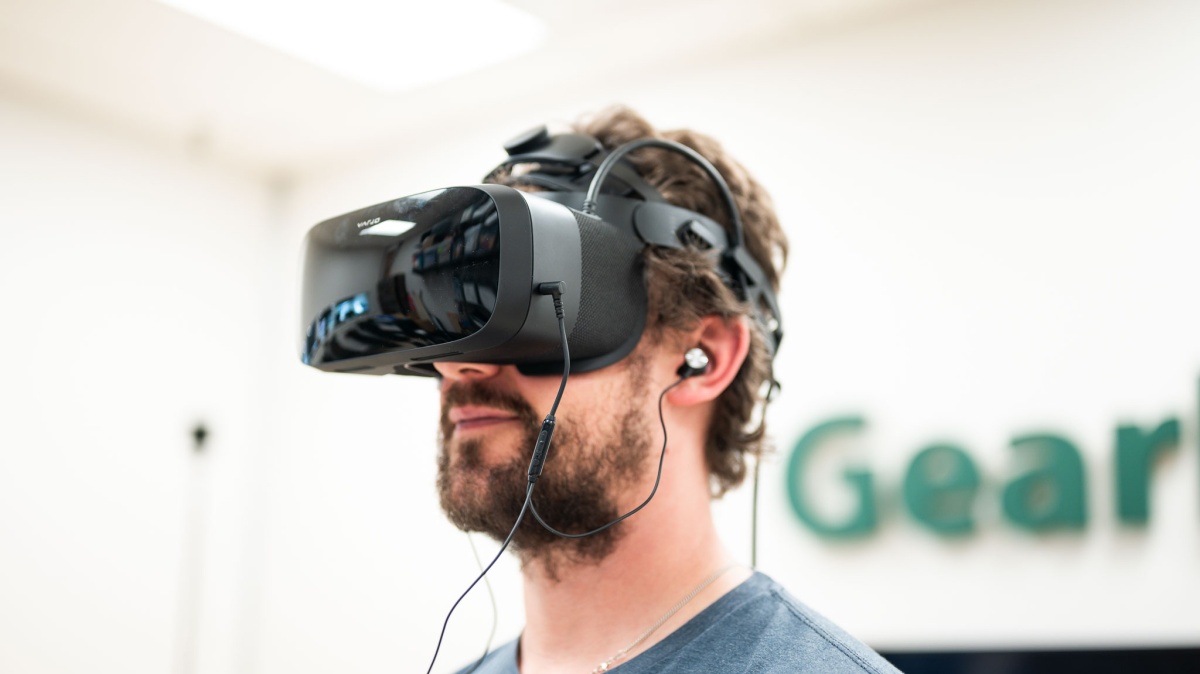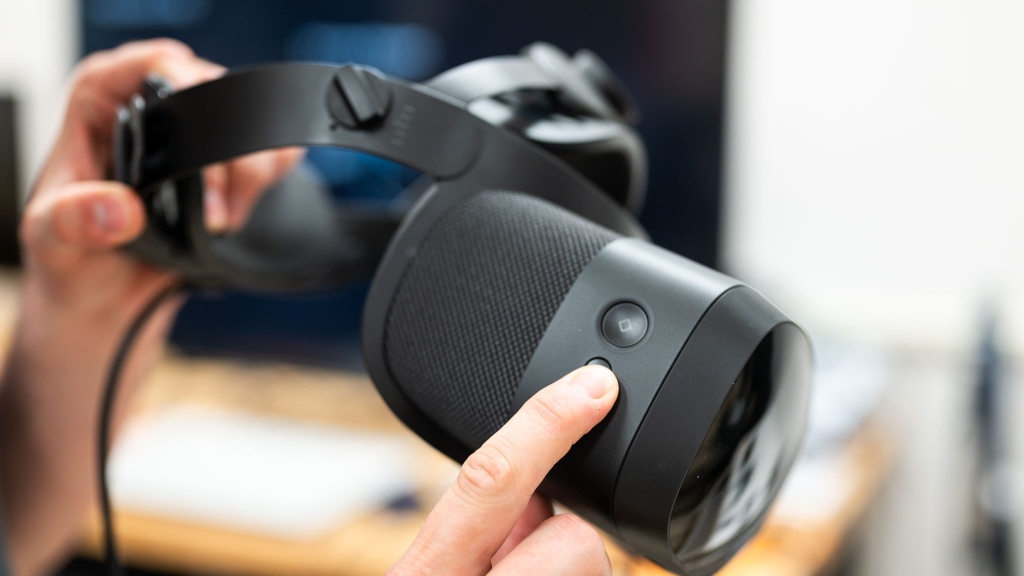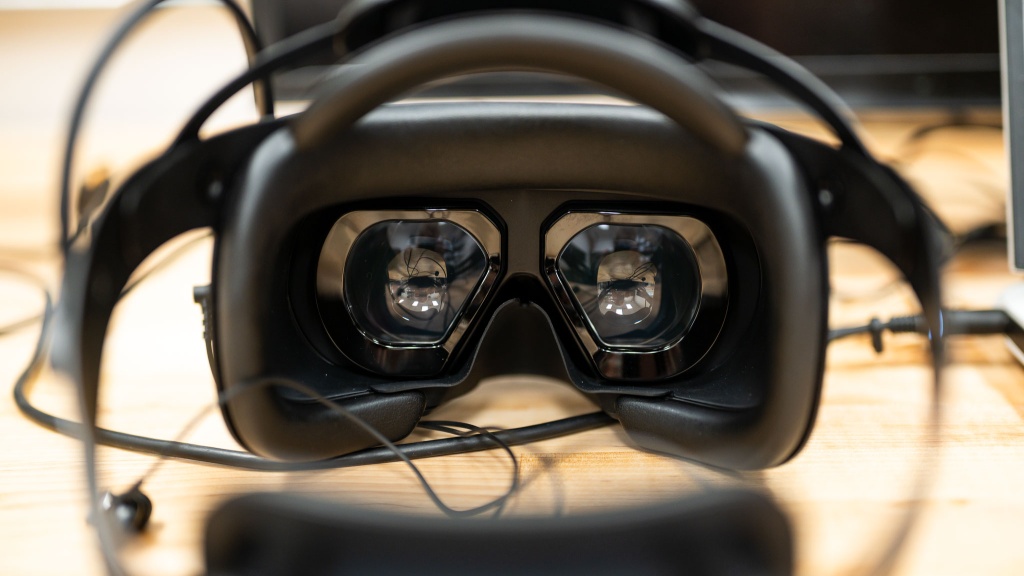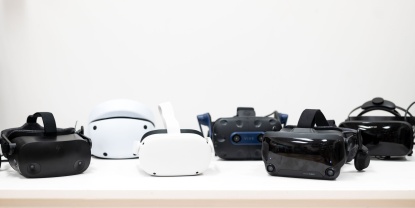Our Verdict
Our Analysis and Test Results
The Varjo Aero is a premium VR headset that stands out from the pack with advanced features like eye-tracking, automatic IPD adjustment, and active cooling. It's as expensive as a standalone headset and even more costly after you've gathered up all of the third-party hardware necessary to track it.
Performance Comparison
Tracking
Our tracking metric gauges the responsiveness and accuracy of VR headsets and motion controllers. The Varjo Aero relies on a minimum of two HTC SteamVR base stations (motion sensors) but recommends four. Since we had them from our Index and Vive tests, we set up four base stations and paired them with two HTC Vive controllers. We put it all to the test in two of our favorite VR games, Beat Saber and Half-Life Alyx, where tracking was about as excellent as you'd expect from so much dedicated hardware.
Tracking in Beat Saber was flawless. The Aero had absolutely no trouble landing precision hits, keeping up with chaotic movement when we were trying to trip it up. Tracking in Half-Life Alyx was good for the most part, but we noticed some hand and weapon blur when moving slowly or trying to sight up and follow an in-game enemy.
Lastly, we'll comment on the the Aero's rare eye-tracking feature. None of the applications we tested it with could take advantage of this feature, so we can't speak to how well it works or feels. Very few eye-tracking games and experiences have been developed so far, but we're sure that will change as developers get their hands on the Aero and next-gen headsets like it.
Comfort
Our comfort metric weighs in on the material and design elements contributing to or detracting from the headset's comfort during play. The Varjo Aero excels in this metric and was one of the most comfortable headsets we tested.
We weighed the Aero at slightly over 1lb 11oz, with the tether cable running down the left side to the PC, for a well-balanced but slightly front-tilted feel. We were most pleased with this headset's unique padded and adjustable top-of-the-head strap, which kept weight off our faces. Likewise, the adjustable side strap is well-designed and works with the padded face mask to dial in a secure and comfortable fit.
One negative we noted about the Aero's comfort level was that it could move around the face a bit during fast head pans, even when tightened snugly. The same goes for glasses compatibility. In this regard, we found the Aero pretty average among VR headsets, which is to say wearing it with glasses is uncomfortable.
When it comes to heat, we know that strapping a chunky brick-sized mask on your face during physical activity will get stuffy, especially when the mask is crammed with heat-radiating electronics. Varjo is the first company to add active-cooling to a VR headset, and it's a fabulous idea. When you put the Aero up to your face, you'll feel the propelled air pushed from the internal fan, keeping your face reasonably cool throughout your VR session.
Visuals
The visuals metric rates the headset's screen clarity and field of view (FOV), two characteristics that can make or break VR immersion. Varjo Aero shines here with a resolution of 2,880x2720 pixels per eye. That's the highest resolution we've ever tested in VR and probably has something to do with the Aero's exorbitant price tag. However, it did not disappoint in our go-to visual test apps: Beat Saber, Half-Life Alyx, and Realovirtual Workshop.
Visual clarity was great in both Beat Saber and Halfy-Life Alyx, with crisp text and graphics and barely-perceptible screen door effect (SDE), an issue that plagues many headsets when the human eye is close enough to a display to pick up individual pixels and the spaces between them. SDE appears much as if you're looking at the virtual world through a mesh screen. Not so much with the Varjo Aero.
The Aero's field of view (FOV) was excellent when measured in our Realovirtual Workshop tests. Varjo claims a 115° FOV, and we were able to see as far out as 110° vertically and 35° horizontally, which is great, but keep in mind that face shape and eyesocket depth play a big part in every individual's FOV in VR headsets.
Daily Use
In this metric we rate VR headsets on the user experience of putting them on and entering VR on a regular basis, as well as the convenience of fine-tuning the fit. Varjo Aero does not score well here.
While we lauded the Aero's comfort and superior adjustability, that adjustability came back to haunt it for daily use. Unlike many of the other VR headsets that maintain their settings after the first fitting, the Aero has to be reset every time — the top and side knobs need to be unwound to get the headset off and rewound to put it back on.
However, one area where the Aero saves time and effort is with its automatic interpupillary distance adjustment (IPD). IPD is the distance between the center of your eyes, and the closer a VR headset's lenses can come to perfect alignment with your IPD, the better. The Aero is the only headset we've tested that can detect your eyes and automatically move the lenses to optimize for IPD. By default, every time you put the headset on, you'll hear a buzzing sound while the lenses align with your eyes, but there are options to deactivate it or change when the IPD alignment occurs. The supported IPD range is 57-73mm.
We aren't fans of the Varjo Aero's earbuds. They were annoying as they dangled around and got in the way when putting the headset on, and the sound quality was disappointing for a two-thousand-dollar headset. The mic is integrated into the earbud cable and works fine. Our friends could hear us in-game but noted occasional cable noise as it was dragged across our clothing in VR play.
Ease of Setup
Our ease of setup metric measures the user experience for the VR headset's initial setup process and weighs additional hardware and PC requirements. In this area, Varjo Aero scored lower than the rest of the class, partially because they recommend extra sensors requiring a more involved setup.
To set the Aero up, you must visit the Varjo website, create a personal or commercial account, and then download and install the Varjo base software. You'll be presented with a welcome screen that checks compatibility with your PC. From there, you're advised to clear your play area of hazards and set up the base stations (motion sensors). Varjo recommends four of them, but two will work. The setup tutorial didn't say anything about pairing controllers or the included earbuds, but it is mentioned in the paper manual that ships with the Aero.
The minimum recommended play area for room-scale VR with the Aero is 6'5" x 5'. Since we used base stations from the Valve Index, the VR boundary setup was identical to the one for that headset. Unlike some kits, where you must carry the headset all around the room dragging the cable, the Aero requires you to stand in the center of your play area, aim the controller at your computer monitor, and pull the trigger. Next, you trace the area using a controller as a pointer, then place both controllers on the floor to register the floor level.
Minimum Windows PC requirements for the Varjo Aero are 8GB RAM, a 4-core Intel i5 or better, RTX 2060 or equivalent, and 2GB storage for Varjo Base software installation. Recommended system specs are much higher and are necessary to get the most from the Aero.
Should You Buy the Varjo Aero?
Because of its uber-steep price, high PC hardware requirements, and the necessity to buy and configure all the tracking equipment a la carte, we don't recommend the Varjo Aero for most people. This advanced kit is aimed squarely at VR developers and enthusiasts who have been around the block and are willing to pay a premium for the advanced immersion and comfort the Aero delivers.
What Other VR Headset Should You Consider?
If you value best-in-class visuals and don't mind trading a little tracking precision for the convenience of a sensorless setup, check out the excellent HP Reverb G2. If you want to skip the hassle and demanding PC requirements, pair up a Playstation 5 with the impressive Playstation VR2 for a well-optimized VR experience.











